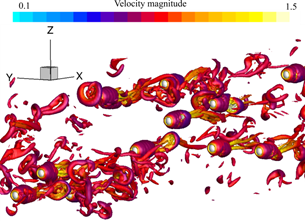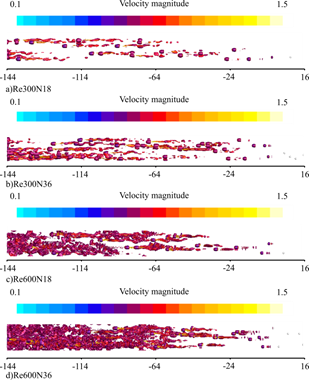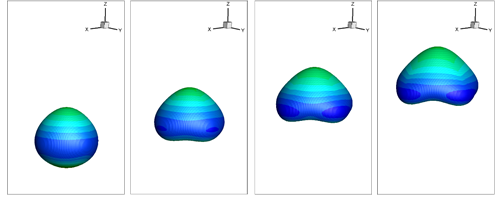Development and application of two-phase flow solver around moving objects
JAXA Supercomputer System Annual Report April 2016-March 2017
Report Number: R16E0044
- Responsible Representative: Shun Takahashi(Tokai University)
- Contact Information: Shun Takahashi(takahasi@tokai-u.jp)
- Members: Shun Takahashi
- Subject Category: Space(Rocket)
Abstract
Two-phase flows with moving objects are commonly used in practical engineering products. This study issubject to investigate the effect of the micro particles in the exhausted gas from the rocket engine to the strong pressure waves and the thermal conductance modification due to the water film around the menisci in the heat pipes. These multiphase flows that are important from the points of the industrial application and the academic interest must be solved by the large scaled simulation.
Goal
We focus on the study for the water injection to the rocket plume from the point of the micro-scale particulate flow exhausted from the rocket engine and the heat transfer mechanism in the heat pipe based on the liquid-gas two-phase flow. These studies are conducted by low-dissipative scheme and Direct Numerical Simulation (DNS) with rapid representation of the complicated boundary interfaces.
Objective
We develop numerical methods to solve the multiphase flows, such as gas-particle, liquid-gas, and liquid-gas-solid flow, stably and easily. The development is based on Cartesian mesh and immersed boundary method to apply practical engineering products related to the moving objects around multiphase flows with accurate prediction of the flow phenomena.
References and Links
N/A
Use of the Supercomputer
The supercomputer is exploited for the simulations of particulate flows and two-phase flows around moving objects. The multiphase flow simulation is developed by immersed boundary method and level set method on Cartesian mesh. The aim of this study is to apply the flow solver for the practical engineering products by using simple program and high extensibility.
Necessity of the Supercomputer
The micro scaled flow is solved by Direct Numerical Simulation for the statistical analysis and modelling to predict the macro scaled flow phenomena and apply to the design of the products. The multiphase flow simulation like a gas-particle flow based on Cartesian mesh and immersed boundary method, however, becomes expensive in order to capture the interaction between particles and flows. Also, the number of the time integration becomes large due to obtain the equilibrium state of the gas-particle flows. The gas-liquid two-phase flow simulation becomes large scale due to the restriction of the time increment from the surface tension.
Achievements of the Year
We obtained numerical results with three dimensional effect around multiple particles at low Reynolds number and high Mach number based on immersed boundary method and Cartesian mesh to compare one-dimensional flow simulation from the point of the energy conversion between the particles and flows.
Also, a numerical method to solve gas-liquid two-phase flows in heat pipes was developed and applied to thermos-fluid phenomena in a heat pipe. A rising bubble problem was used to the validation of the flow solver consisting of conservative level set method.

Fig.1:Vortex structure identified by the isosurface of second invariant value of the velocity gradient tensor around multiple particles
Publications
Peer-reviewed articles
1) Nagata, T., Nonomura, T., Takahashi, S., Mizuno, Y., and Fukuda, K., ‘Investigation on subsonic to supersonic Flow around a Sphere at Low Reynolds Number of between 50 and 300 by Direct Numerical Simulation,’ Physics of Fluids, API Publishing, Vol. 28, No. 5, 056101, 2016.
Presentations
1) Mizuno, Y., Takahashi, S., Nonomura, T., Nagata, T., Fukuda, K., ‘Gas-particle flow simulation based on Compressible Flow Solver with Immersed Boundary Method’, Parallel Computational Fluid Dynamics 2016, 2016.
2) Mizuno, Y., Takahashi, S., Nonomura, T., Nagata, T., Fukuda, K., ‘Direct Numerical Simulation with Heat Transfer of Gas-Particle Flow containing Shock Waves by Immersed Boundary Method’, International Conference on Multiphase Flow 2016, Firenze, Italy, May, 2016.
3) Nagata, T., Nonomura, T., Takahashi, S., Mizuno, Y., and Fukuda, K., ‘Direct Numerical Simulation of Flow around a Rotating Sphere at High Mach and Low Reynolds Numbers Condition forsupersonic Gas-Particle Flow Analysis,’ International Conference on Multiphase Flow 2016, Firenze, Italy, May, 2016.
4) Nagata, T., Nonomura, T., Takahashi, S., Mizuno, Y., and Fukuda, K., ‘Investigation on Wake Vortex Structure of a Heated/Cooled Rotating Particle in Compressible Flows by Direct Numerical Simulation,’ 7th International Conference on Vortex Flows and Vortex Models, Rostock, Germany, September, 2016.
Computational Information
- Parallelization Methods: Process Parallelization,Thread Parallelization,Hybrid Parallelization
- Process Parallelization Methods: MPI
- Thread Parallelization Methods: OpenMP
- Number of Processes: 45, 92
- Number of Threads per Process: 2, 2
- Number of Nodes Used: 6
- Elapsed Time per Case (Hours): 300, 410
- Number of Cases: 80, 20
Resources Used
Total Amount of Virtual Cost(Yen): 3,422,103
Breakdown List by Resources
| System Name | Amount of Core Time(core x hours) | Virtual Cost(Yen) |
|---|---|---|
| SORA-MA | 1,414,653.05 | 2,196,801 |
| SORA-PP | 130,553.85 | 1,114,668 |
| SORA-LM | 0.00 | 0 |
| SORA-TPP | 0.00 | 0 |
| File System Name | Storage assigned(GiB) | Virtual Cost(Yen) |
|---|---|---|
| /home | 9.54 | 89 |
| /data | 9,765.63 | 92,119 |
| /ltmp | 1,953.13 | 18,423 |
| Archiving System Name | Storage used(TiB) | Virtual Cost(Yen) |
|---|---|---|
| J-SPACE | 0.00 | 0 |
Note: Virtual Cost=amount of cost, using the unit price list of JAXA Facility Utilization program(2016)
JAXA Supercomputer System Annual Report April 2016-March 2017




